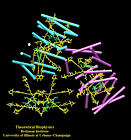Highlights of our Work
2024 | 2023 | 2022 | 2021 | 2020 | 2019 | 2018 | 2017 | 2016 | 2015 | 2014 | 2013 | 2012 | 2011 | 2010 | 2009 | 2008 | 2007 | 2006 | 2005 | 2004 | 2003 | 2002 | 2001

image size:
195.0KB
made with VMD
A photosynthetic variant explains how nature harvests sunlight. Most photosynthetic life forms employ mainly chlorophylls for absorbing sun light and fueling its energy into their metabolism. However, dynoflagellates, e.g., the species Amphidinium carterae, utilizes predominantly carotenoids for light absorption. Biophysicists have computed the electronic properties of a key light harvesting protein of Amphidinium carterae, peridinin-chlorophyll-protein, and in comparing their results with properties known for more conventional photosynthetic systems have learnt how biological evolution molded efficient solar batteries and what principles guided the evolution of photosynthesis (see resulting publication).



